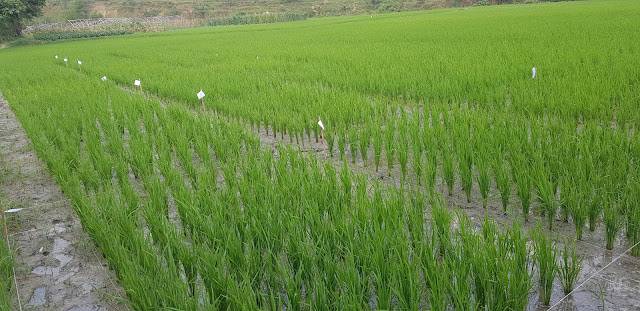Agriculture related policies in Nepal
- Get link
- X
- Other Apps
A. Introduction
To
reduce poverty, increase the income of the people, and overall prosperity of the country, the growth, and development of the Nepalese agricultural sector are crucial
The government of Nepal enacted the
Local self-Governance Act
B. Objectives
of policies in Nepal
Ø High
priority on diversification, modernization, commercialization, and promotion of the agriculture sector.
Ø Important
role of the private sector to promote commercial farming.
Ø Promotion of
internal and external markets.
Ø Agri-business
service centers establishment for quality agriculture inputs services.
Ø Infrastructure
development for processing and marketing as a foundation for commercialization
and diversification.
Ø Promotion of
partnership approach between government and the private sector for agriculture
development.
Ø Private
sector involvement for the export of quality goods and market network.
C. Major
policies related to Agriculture
Major agricultural policies related
to agriculture in Nepal and their functions are listed below:
1. National
Agriculture policy
The agricultural sector's
long-term objective is to increase people's living standards through
sustainable agricultural development, which will be achieved by changing the
current subsistence-oriented farming system into a commercial and competitive
one-
·
Agricultural
production and productivity shall be increased.
·
The
bases of a commercial and competitive farming system shall be developed and
made competitive in the regional and world markets.
·
Natural
resources, as well as the environment and bio-diversity, shall be conserved,
promoted, and properly utilized.
Major
focuses of National Agriculture Policy-2061
·
Agriculture production and
productivity
·
Special Facilities like land
banks and infrastructure installment for target groups of Dalits, Utpidits,
marginal farmers, and other agricultural workers.
·
Development of a commercial
and competitive farming system.
·
Conservation, promotion, and
utilization of natural resources and environment.
2.
Agribusiness promotion policy-2063
This policy was Formulated with the objectives of
transforming a subsistence-oriented and dispersed agricultural production system
into a modern, sustainable, competitive, and commercial production system. Some
objectives are:
·
To support the production
of market-led and competitive agriculture products.
·
To promote domestic market and
export promotion by developing agri-enterprises.
·
To support poverty alleviation
by the commercialization of agriculture.
The major focus of
ABPP-2063
·
Establish and develop
extensive growth centers based on geographic, technical and economic
potentialities.
·
Establish and promote
"Business Development Service Centre", be compatible and coordinate
with special economic zone program.
·
Subsidized import tax of
machines and equipment up to 75%.
·
Provision of agribusiness loan
liberal repayment strategy.
·
Price determination system.
·
Foreign Direct Investment
(FDI) promotion for agribusiness development and extension.
3.
Agriculture perspective Plan (1995-2015)
The Agricultural Perspective Plan (APP) was a national
strategy with a cross-sectorial approach with a duration of twenty years
(1995-2015). The APP strategy is based on the acceleration of the agricultural
growth rate sufficiently to obtain a strong multiplier effect on growth in
employment, both in agriculture itself and in nonagricultural sectors. Its
objectives are:
·
To accelerate the growth rate in agriculture through
increased factor productivity.
·
To alleviate poverty and achieve significant improvement in
the standard of living through accelerated growth and expanded employment
opportunities
·
To expand opportunities for an overall economic
transformation by fulfilling the precondition of agricultural development.
Major Priorities of APP
·
Priority Inputs (Fertilizer,
Irrigation, Road & Power, Technology)
·
Priority (High value crop,
Agribusiness, Livestock, Agro-forestry)
Although it was seen with a
policy of national pride, it gave mixed performance.
·
Good progress: High value
commodities, vegetable, Livestock (poultry, Dairy), Rural road expansion
·
Moderate progress: Cereal
crops, irrigation, fertilizer, technology and power.
Critical factors for mixed performance
·
Poor co-ordination
·
Policy Inconsistency
·
Design fault (Seed was not
priority input)
·
Lack of ownership by others
than MoAD, and NPC to an extent.
4.
National
Coffee policy-2060
5.
National
Tea policy-2057
6.
National
Seed policy-2056
7.
National
fertilizer policy-2058
8.
Agriculture
Biodiversity policy-2063
Agro-biodiversity
policy of Nepal has the vision to:
·
Conserve
·
sustainable
use of resources
Some of the
objectives of this policy are:
·
To
enhance agricultural growth and ensure food security by conserving, promoting, and sustainability
·
To
protect and promote the rights and welfare of farming communities
·
To
contribute to maintaining the sustainable ecological balance
9. Dairy
development policy-2064
This
policy has been developed with the view of the importance of the livestock sub-sector
in the Nepalese farming sector. The long-term vision is to encourage the participation
of public, private, and co-operatives sectors in milk production.
Some major
objectives are:
·
To
increase production and productivity of milk in rural areas
·
To
diversify milk products for import substitution and promotion of export
·
To
control and regulate the quality of milk and milk products
10. Irrigation
policy-2070
11. Commercial agriculture
policy-2064
12. Industrial policy-2067
13. Floriculture promotion policy-2069
14. Climate change
policy-2072
15. Commerce policy-2072
16. Agriculture Mechanization promotion
policy-2071
17. Nepal Integration strategy-2010
18. Nepal Integrated Trade Policy-2010
19. Agriculture
Development Strategy:
ADS has analyzed the causes contributing to
the failure of APP, identification of targets, and indicators for the
quantification of the attainment of the identified targets. ADS has expected in
the growth of agriculture sector and agri-business in the coming 20 years. ADS
should focus on producing products that are competitive in the market based on international standards.
It targets:
·
increasing the volume of food production in Nepal in a
sustainable way through higher productivity and sustainable use of natural
resources;
·
reducing vulnerability of farmers through improved
food/feed/seed reserves,
·
improved preparedness and response to emergencies,
·
climate-smart agricultural practices
·
increasing income of farmers
·
improving access to markets; reducing post-harvest losses;
·
improving food safety;
relying upon trade for a more diversified diet;
·
accelerating the growth of micro, small, and medium
agro-enterprises including those headed by women, youth, disadvantaged groups,
and individuals based in disadvantaged regions
D.
Conclusion:
To
transform subsistence and traditional level of farming practices along with
infrastructures, proper effective policies are needed. The existing policy
related to agriculture sectors must be updated to balance with the present
terms and conditions of producers and consumers for smooth production and distribution
of the commodity. More policies to target marginalized and backward farmers
must be formulated to uplift the overall condition of agriculture and the agriculture-related sector. The outdated policies that don’t justify the
situation of producers and consumers and affect the channel of marketing must
be removed for affirmative progress of the agricultural sector.
E. Bibliography
ADS. (2014). Agriculture Development Strategy
(2015-2035). Part 1 and Part 2. Kathmandu, Nepal: Ministry of Agriculture
and Livestock Development, Government of Nepal.
APP. (1995). Nepal Agriculture Perspective Plan
(1995/96-2014/15). Final Report. Washington, D.C.: Agriculture Project
Services Centre Kathmandu and John Mellor Associates,Inc.
MoAC. (2004). National Agriculture Policy 2004.
Kathmandu,Nepal: Government of Nepal, Nepal Law Commission.
NPC. (2019). Annual Development Programme of FY
019/20. Singha Darba, Kathmandu: Government of Nepal,National Planning
Commission.
Thapa, T. (2005). Review of Agricultural Extension
System in Nepal. Proceedings of National Agriculture Extension workshop,
61.
Thapa, T. B. (2010). Agricultural Extension Services
Delivery System in Nepal. Food and Agriculture Organization of the United
Nations. .
Upreti, B., & M-B. U. (2010). Livelihood
insecurity and social conflict in Nepal. RCO NCCR North-South.
- Get link
- X
- Other Apps


Comments
Post a Comment